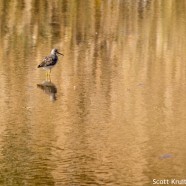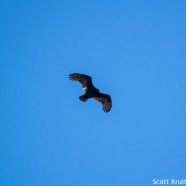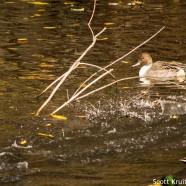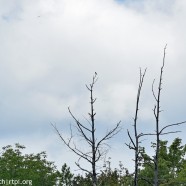Greater Yellowlegs feeding alone
This Greater Yellowlegs was found foraging alone in a shallow, still and serene November pond. It may seem lonely in this location but many of its friends and counterparts, I am certain, were not far away. A bunch of long-legged waders were enjoying the same waters. On that very day I recorded Dunlin, Sanderling, Black-bellied Plovers, and likely Short-billed Dowitchers. Who said shorebirding in New England couldn’t be a Thanksgiving sport? Thanks, climate change! Scott Kruitbosch Conservation & Outreach Coordinator
Read MoreTurkey Vulture (Cathartes aura)
Here’s a Halloween-themed sight! Non-hawk watchers often ask me, “How do you know if a Turkey Vulture is migrating?” instead of it soaring around looking for a meal. Even this photo can help explain that to some degree. Most folks, even non-birders, can picture a Turkey Vulture in the sky with wings extended, held straight, in a dihedral – wings angled above horizontal. Sometimes this is dramatic and the bird looks like it is making a V. However, if this photo was a silhouette you may think Osprey before anything else. Turkey Vultures on the move at lofty heights,...
Read MoreNorthern Pintails: male and female
As we get deeper into autumn we also receive a greater diversity of waterfowl joining us in the Northeast. I wanted to share some photos of male and female Northern Pintails (Anas acuta) that I took last week in the middle of a large flock of Mallard and American Black Duck. Some of them were more interested in mating than anything else making it difficult for the Pintails trying to feed, preen and stretch. I noticed the male first due to its distinctive plumage that always helps it stands out well in a crowd. Northern Pintails are slender birds and males have a long, pointed tail that help...
Read MoreIdentify this silhouette at a distance
I spotted this bird at RTPI today from a distance without binoculars and knew its identity immediately. Standing in our garden I could see the basic silhouette and how it had positioned itself. Those two clues plus the date should help you determine the species as well. Any ideas? If you do not want to know the answer don’t keep reading…did you figure it out yet? It’s…an Olive-sided Flycatcher! I had one of the uncommon southbound migrants last August as well but it was my first of 2014. I watched it feeding for a while as I looked for butterflies, the bird grabbing...
Read More







